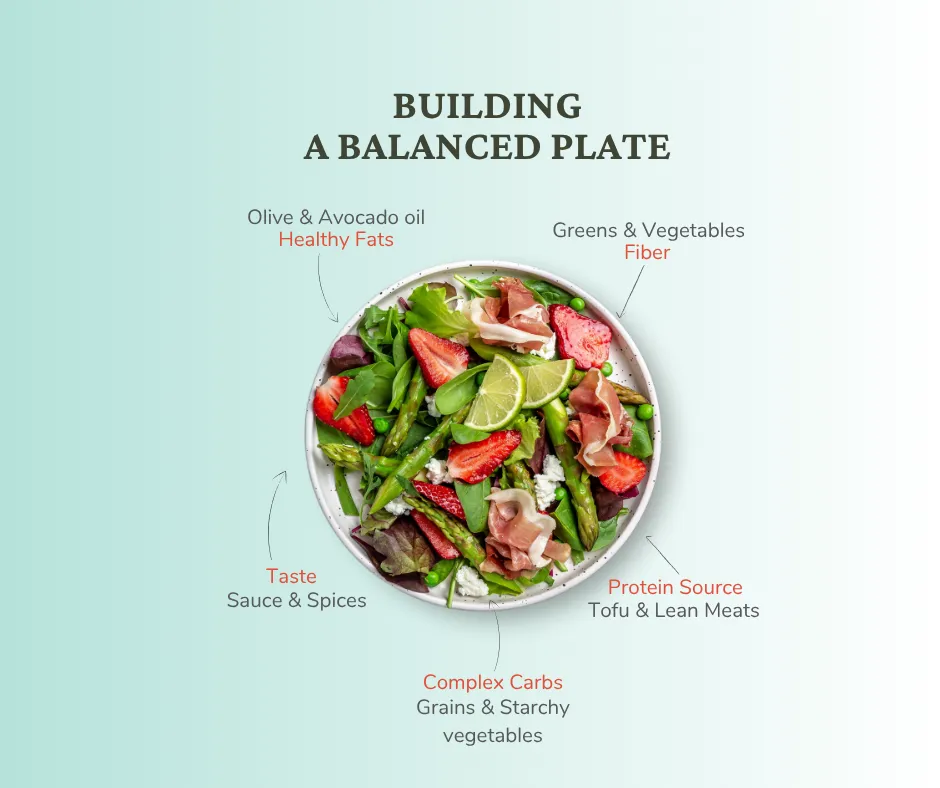
Building a Balanced Plate for Healthy Eating
Building a Balanced Plate for Healthy Eating
Having a balanced plate at every meal is important for maintaining good health and nutrition. Let’s explore how to easily build a balanced plate using simple steps and guidelines. This will help ensure that you get all the nutrients your body needs. Here's how to create a healthy, balanced meal:
1. Healthy Fats: Olive & Avocado Oil
Fats are an essential part of our diet. They provide energy and help our body absorb vitamins. Healthy fats, like olive and avocado oil, are great choices. They contain beneficial fat that can improve heart health and give you energy throughout the day.
Olive Oil: a good source of monounsaturated fats.
Avocado Oil: rich in vitamin E and healthy fats.
Including these oils in your meals can make a big difference in providing the right kind of fats for your body.
2. Fiber: Greens & Vegetables
Fiber is vital for keeping our digestive system healthy. It helps our body process food and maintain a happy stomach. Greens and vegetables are packed with fiber and are essential to any balanced plate.
Leafy Greens: such as spinach, kale, and lettuce.
Colorful Vegetables: like bell peppers, carrots, and peas.
Make sure to fill at least half of your plate with vegetables and greens. They are low in calories but rich in nutrients, which keeps you full and satisfied.
3. Protein Source: Tofu & Lean Meats
Proteins are the building blocks of our body. They help build and repair tissues. It's important to include a good protein source in every meal.
Tofu: a plant-based protein that's perfect for vegetarians and vegans.
Lean Meats: such as chicken, turkey, or fish are excellent sources of protein.
Balancing different protein sources can keep your meals interesting and nutritious.
4. Complex Carbs: Grains & Starchy Vegetables
Carbohydrates are an important energy source for our bodies. Choosing complex carbs means you're picking foods that process slower, providing full, long-lasting energy.
Whole Grains: like brown rice, quinoa, and whole-grain pasta.
Starchy Vegetables: such as sweet potatoes and corn.
Integrating these into your meals ensures you're powered up for the day without feeling sluggish.
5. Add Some Taste: Sauce & Spices
Although healthy eating is crucial, enjoying your meals is just as important. Adding sauces and spices can make healthy foods more enjoyable.
Sauces: Use healthier options like homemade tomato or pesto sauce.
Spices: Experiment with spices like turmeric, cumin, and garlic to boost flavor without adding unhealthy calories.
Creating a tasty and balanced meal means you’re more likely to stick with healthy eating habits.
Why Is a Balanced Plate Important?
A balanced plate can lead to:
Better Nutrition: Provides a variety of vital nutrients your body needs.
Improved Health: Supports a healthy weight and reduces the risk of chronic diseases.
Energy Boost: Balanced meals provide more energy and less fatigue.
Taking the time to think about what you put on your plate can lead to significant positive changes in your health and well-being. Remember, the key to healthy eating is balance, variety, and moderation. So next time you build your plate, consider these simple guidelines to make tasty and nutritious choices.